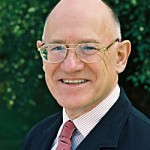Listening Cherry 09 – Michael Swan – receptive pronunciation

Michael Swan is a revered figure in the field of English Language Teaching. But he can also be very forthright in his opinions, and so two years ago, it was with some trepidation that I saw that he had quoted a review of mine of Robin Walker’s Teaching the Pronunciation of English as a Lingua Franca (Cauldwell, 2012). But ‘Phew!’ I wasn’t a target, it was simply a quotation to start off a discussion. This is what he quoted:
I have a (probably naive) hope that we can have a single model of speech which can encompass/capture both (a) pedgogic advice for maximal clarity and intelligibility in pronunciation on the one hand, and (b) the speeds, reductions, disfluencies and lack of clarity of spontaneous speech for listening on the other hand.
He then suggests that some languages – such as Japanese – the relationship between the slow clear style of speaking and speeded up speech is a manageable one – the word he uses is ‘hospitable’. But he goes on to say
French, on the other hand, is awful. At high speed it sheds unstressed schwa vowels all over the place, ending up with consonant clusters that make Russian looks soft and cuddly: ce que je ferais > /skʃfre/. English, too, is down toward the unfriendly end of the scale.
And he goes on to argue that the non-core items which are not needed for production, are needed for what he terms ‘receptive pronunciation’
for receptive pronunciation the productive priorities are pretty much reversed – it is precisely the so-called ‘non-core’ elements that may have the greatest importance for teaching.
I think the term ‘receptive pronunciation’ is an interesting one: it encapsulates very strongly, it seems to me, the idea that the teaching of listening and pronunciation can be thought of as a unified, integrated enterprise. (I’ll return to this point in a future posting).
However, his argument seems to move towards the idea of separation (‘priorities are pretty much reversed’), that we should be looking at different outcomes for pronunciation and listening – he seems very largely accepting of the ELF core items for pronunciation, but he really wants to include the non-core items for the teaching of listening.
I have been wrestling with the nature of the relationship between listening and pronunciation for many years (c.f Cauldwell, 2003), and I am continuing to do so. So, more on this next time.
Cauldwell, R. (2011). [Review of] Teaching the Pronunciation of English as a Lingua Franca. [Robin Walker, OUP] Speak Out! 45, pp. 24-25
Cauldwell, R. (2003). The two-sides rule in teaching listening and pronunciation. [Online article] Developing Teachers here
Swan, M. (2012) Grammar and Pronunciation. Speak Out, 47, pp. 21-23.



Leave a Reply